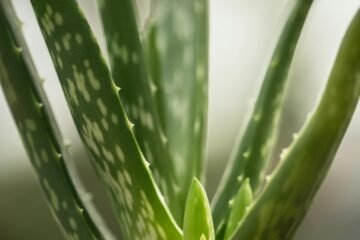Monstera Adansonii, or Swiss Cheese plant, is a beautiful and unique plant that is similar to tropical rainforest regions of central and South America. The Swiss Cheese plant gets its common name from it’s large and glossy leaves with heart-shaped.
The Swiss Cheese plant is a fast-growing plant and easy to care for and makes an excellent addition to any indoor jungle.
So keep knowing and share your green love with your family and friends by giving thumbs.
Common Name Swiss cheese plant, Swiss cheese vine, five holes plant, cheese plant
Botanical Name Monstera adansonii
Family Araceae
Plant Type Perennial
Mature Size 10–13 ft. tall (outdoors), 3–8 ft. tall (indoors), 1–3 ft. wide
Sun Exposure Partial
Soil Type Moist, well-drained
Soil pH Acidic, neutral
Bloom Time Spring (does not bloom indoors)
Flower Color White
Hardiness Zones 10–12 (USDA)
Native Area Central America, South America
Toxicity Toxic to pets
Swiss Cheese Plant Care
Provide well-draining soil for your cheese plant.
Water your cheese plant regularly; let the soil dry out and then moisten thoroughly.
Add a stake or moss pole to the center of the pot to give your Swiss cheese plant a structure to climb on
Fertilize your cheese plant with a balanced houseplant fertilizer, after it is well-established.
Prune your cheese plant lightly and regularly as needed.
Light
Monstera adansonii needs a medium to bright but indirect light to grow. Too much exposure can burn the foliage. If direct sunlight is unavoidable, limit its exposure to just two or three hours of the morning sun.
Soil
Swiss cheese plants grow best in a potting mix. For strong growth, keep soil pH between 5.5 and 7.
Water
I always say water your plant when your plant soil get dry and water it properly.
Temperature and Humidity
The Swiss cheese plant is a tropical rainforest plant like Monstera deliciosa. Its like high humidity (Avobe 50%) and warm temperatures of 60 F to 85 F.
Fertilizer
Swiss cheese plants are tropical rain forest, which means there is too much nutrition and light. A balanced fertilizer made for houseplants. In this case i always go for (33,33,33) coconut,compost and natural fertilizer. It should be applied monthly during the growing season (May to september).
Staking and support
The propical rain forest plants use the rutes from other plants to climb high. For houseplants you can use a wood stake in the middle of the pot.
Pruning
The swiss cheese plant is a climber, so it might need to be pruned if it begins to outgrow your space. The best time to prune a swiss cheese plant is in spring ( you can propagate anything you cut ) always take back stems not more than 25 percent.
How to propagate Swiss Cheese plants
The Swiss Cheese plant can be propagate by seeds and stem cuttings. Very easy to propagate from stem cuttings. You need some tools on hand to make this process fast and smooth.
Tools and Equipment needed
To propagate Swiss Cheese plant you need the Following equipment:
- A Sharp knife
- A clean, empty pot or container
- Fresh, well-draining potting mix
- Rotting hormone
- A humidifier or humidity tray
Once you collect the tools you are ready to take a cut and propagate your plant. It’s also a good idea to cover your workplace with either a towel or some plastic to make cleanup fast.
When you take a cut you must ensure the home environment. Because it’s not ideal to take a cut from somewhere that is totally different from this plant’s natural environment. It will save from unnecessary stress to both the parent plant and cutting.
Taking Cuttings From Swiss Cheese Plant’s
The easiest and fastest way to propagate Swiss Cheese plant from a cutting
How To Take A Cutting
To take a cutting I always say go for the most healthy and strong stem that is at least 5-6 inches long. Cut the stem just below the node (the point where leaves emerge) using a sharp knife.
Propagating Swiss Cheese Plants
After cutting, there are two ways to make a new plant. You can go for water or direct in soil both are easy.
For me I do it from water, it’s more easy to take care.
Rotting In Water
To root your brand-new cutting in water, you need a jar, some fresh water, rooting hormone and some plastic. First, fill your jar with water and put the plastic wrap over the opening. Then cut a hole center of the jar and put the cutting in.
Place your jar somewhere it will receive indirect sunlight, and replace the water in two to three days. You can add rooting hormone when you change the water it will help it grow fast. Usually it takes two to eight weeks so be patient!
Once your cutting has a good set to roots, you can plant it in a pot with well-draining soil.
Common Problems After Propagating Swiss Cheese Plants
Yellow or brown leaves: The leaves of your Swiss Cheese plant cuttings may turn yellow or brown. This is usually caused by direct sunlight or not enough humidity.
Leaves turning black: Black marks on the leaves can be sign of leaf burn from direct sunlight. Watch your plant throughout the day and make sure the direct sun isn’t hitting it for a long time.
Leaves not splitting: The fenestration (splitting) habit of montera is what gives it the distinctive look loved by the growers. The cause of your monstera’s leaves not splitting is too little light. Make sure that you put your plant in proper sunlight.




0 Comments